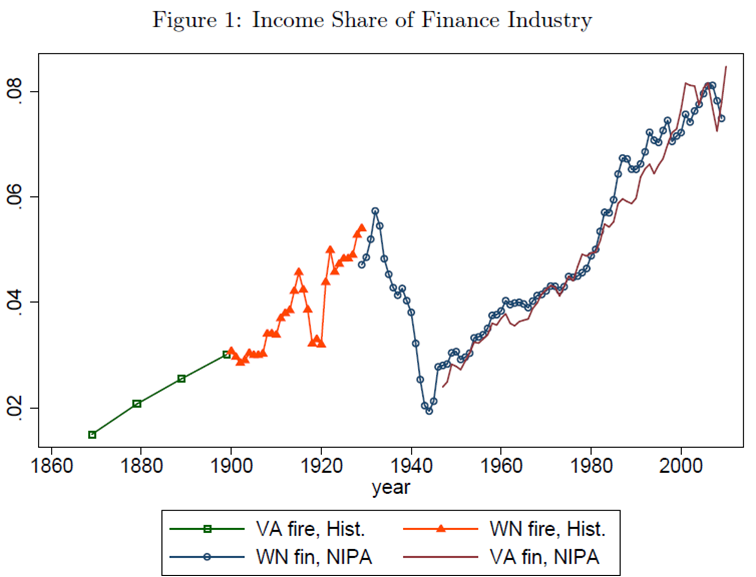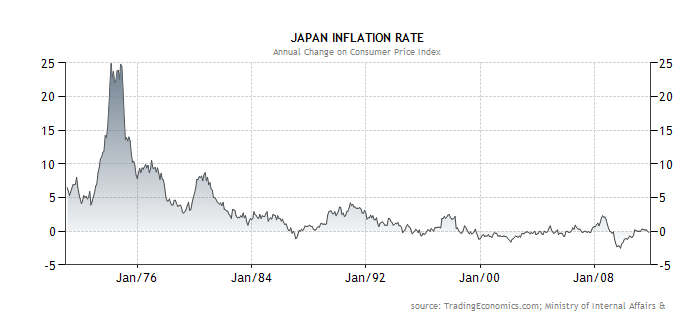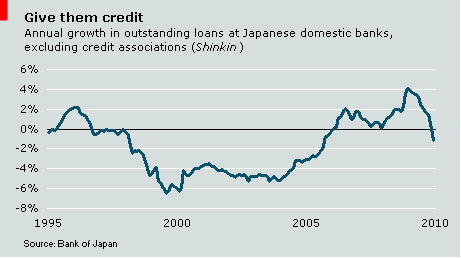In the blogosphere, David Graeber is known as a sort-of-leftish guy with a tendency to fight with other people on the left (he has called Slavoj Zizek an "
intellectual comedian" and carried on a
lengthy feud with Crooked Timber). But in the world at large, Graeber - an anthropologist by training - is known for writing
Debt: The First 5,000 Years, a history of...well, the phenomenon of debt. He has also been called the "
anti-leader" of the Occupy Wall Street movement (of which I confess to being a bit of an armchair fan). In fact, Graeber is rumored to have personally coined the term "Occupy Wall Street" (though this is unconfirmed). So objectively, he's actually kind of a big deal.
It’s now clear that the 1 percent are the creditors...The overriding imperative of government policy is to do whatever it takes, using all available tools—fiscal, monetary, political, even military—to keep stock prices from falling...
The overwhelming majority of Occupiers were, in one way or another, refugees of the American debt system. At first, that meant student debt: the typical complaint was “I worked hard and played by the rules, and now I can’t find a job to pay my student loans—while the financial criminals who trashed the economy got themselves bailed out.”...
We [have] come to see ourselves as members of the same indebted class...
The rise of OWS allowed us to start seeing the system for what it is: an enormous engine of debt extraction. Debt is how the rich extract wealth from the rest of us, at home and abroad. Internally, it has become a matter of manipulating the country’s legal structure to ensure that more and more people fall deeper and deeper into debt. As I write, roughly three out of four Americans are in some form of debt, and a whopping one in seven is being pursued by debt collectors.
Reading this, one small point immediately jumped out at me - the bit about stock prices. According to Graeber, the people who control the government are A) creditors, and B) will do anything to boost stock prices. But - as anyone who reads the news should know - the main thing the government does to boost stock prices is to
lower interest rates and/or print money. And yet creditors are very angry about this, first of all because they fear that money-printing will cause inflation (which erodes the value of the debt they hold), and also because they can't get much of a return on the money they lend in the future. If you don't believe me, read
The Economist or
Fox Business complaining about how low interest rates hurt savers (i.e. creditors).
So the government's efforts to boost stock prices are actually making creditors very mad. The interests of stockholders and creditors are at odds. Why doesn't Graeber seem to know this?
In fact, this small inconsistency turned out to be a canary in a coal mine. The more I read over Graeber's arguments, the more I realized that many of his ideas about debt seem either contradictory or confusing. Here are my main questions:
...Who?? ...Whom??
"Debt," says Graeber, "is how the rich extract wealth from the rest of us." But sometimes he seems to claim that creditors are extracting wealth from debtors, and sometimes he seems to claim that debtors extract wealth from creditors.
For example, in the
Nation article, Graeber tells that The 1% are creditors. We, the people, have had our wealth extracted from us by the lenders. But in his book, Graeber writes that empires extract tribute from less powerful nations by forcing them to lend the empires money. In the last chapter of
Debt, Graeber gives the example of the U.S. and China, and claims that the vast sums owed to China by America are, in fact, China's wealth being extracted as tribute. And in
this Businessweek article, Graeber explains that "throughout history, debt has served as a way for states to control their subjects and extract resources from them (usually to finance wars)."
But in both of these latter cases, the "extractor" is the debtor, not the creditor. Governments do not lend to finance wars; they borrow. And the U.S. does not lend to China; we borrow.
So is debt a means by which creditors extract wealth from debtors? Or a means by which debtors extract wealth from creditors? (Can it be both? Does it depend? If so, what does it depend on? How do we look at a debtor-creditor-relationship and decide who extracted wealth from whom?) Graeber seems to view the debtor/creditor relationship as clearly, obviously skewed toward the lender in some sentences, and then clearly, obviously skewed toward the borrower in other sentences.
But these can't both be clear and obvious.
How can I extract wealth from the powerless? Inquiring minds want to know.
OK, so here's a pragmatic question. As a newly minted finance professor who writes blog posts
defending the Efficient Market Hypothesis, I am now a card-carrying member of America's white-collar mafia. I'm a member of the 1% in spirit (if not actually in income or wealth). So I want to know: How can I pull off the feat with which Graeber credits the creditor class? How can I get rich extracting wealth from the poor and powerless by lending them money?
Well, one thing I could do is to lend some poor people money, and make money off of the interest payments when they pay back the loan. Am I then extracting wealth from them? Well, maybe. But if they were willing to take out the loan, and willing to pay me back - if they intended to pay me back from the very beginning, and followed through - then didn't they benefit somehow from borrowing the money? Maybe they got a house out of the bargain, or a car. In any case, I charged them for a product, and they paid for the product, knowing what they were getting.
Did I really "extract wealth" from them? And if so, does a grocery store "extract wealth" from me every time I buy a grapefruit?
OK, so instead suppose I lend the poor people more than they can afford to borrow. I trick them on the terms of the loan, offering them a low "teaser" rate that balloons after a few years, and I conceal this in the fine print and lie to them and tell them that they'll be able to pay it back. (This is certainly possible.) So then they default on the loan. They go into bankruptcy, their house gets repossessed, etc. So they lost out.
But didn't I lose out too? After all, I didn't get paid back! I took a loss! Not a very good method for extracting wealth, it seems to me.
OK OK, new idea. Suppose I sell poor people an exploding loan that they'll never be able to pay back, then package this loan off and resell it to Goldman Sachs. When the poor people default, Goldman Sachs takes a hit and I'm in the black. Money extracted!
But did I extract the money from the poor people, or from my fellow One Percenters at Goldman Sachs? Remember, the poor people took a hit from the bankruptcy, but in the meantime they got to borrow some money and not pay it back, due to the protection afforded them by bankruptcy law.
(But didn't Goldman get bailed out by the government when this happened? Sure, but Goldman actually paid the taxpayer back for that bailout, and Goldman's shareholders - One Percenters - took the hit.)
OK OK OK. NEW idea. Suppose poor people could borrow money for 3% if they knew where to look. but they don't know where to look, so I lend them money at 22%. The people pay me back, but they end up paying a lot more than if they had only known they could borrow at 3%. So by tricking them into thinking that 22% was the best interest rate they could get, I extracted wealth from them.
This seems like a good scheme. Can people be tricked? Of course they can - otherwise "con man" wouldn't be a real job.
This scheme sounds like a winner. But it makes me wax philosophical. Was it the debt that extracted the wealth, or the trick itself? If I sell people a crappy car that breaks down two days after they drive it off the lot, does that mean that cars are a tool for extracting wealth from the poor? Or does it mean that deception in general is a tool for extracting wealth from the poor, and crappy cars, like crappy loans, are just one kind of crappy product that people can be tricked into buying?
Well, maybe I'm splitting hairs here. Maybe I should just stop philosophizing and bend my mind to the task of tricking people into paying higher interest rates than they have to...But it certainly seems to me that Graeber is a bit unclear on exactly how debt "extracts" wealth.
What should we do about debt?
In his article in the Nation, Graeber writes:
Debt cancellation of some sort is going to take place...A debt jubilee, after all, affords the possibility not just of economic renewal, but of intellectual and spiritual renewal as well...if I were to frame a demand today, it would be for as broad a cancellation of debt as possible, followed by a mass reduction of working hours—say to a five-hour workday or a guaranteed five-month vacation.
OK, I admit, I just quoted the part about the five-month vacation because it was an entertaining nonsequitur. But what about this debt cancellation?
Is a one-time debt cancellation all we need to do to remove the problem of exploitation-by-debt? Or do we need to change the way debt works in our society in order to prevent the exploitation from recurring?
One thing we could do is to have periodic debt cancellations, either pre-announced or random. Either way, what that would do is make lenders very unwilling to lend. Interest rates would go way up, because that would be the only way that lenders could turn a profit lending money.
Would this be a good thing? Well, if debt equals exploitation of borrowers, maybe it would be. Or you could just ban people from taking out debt (or ban the payment of interest, as in strict Islamic law).
But then, people wouldn't be able to borrow to buy houses. They wouldn't be able to borrow to buy cars. They wouldn't be able to borrow to finance their education (as I myself have done twice now). Would this not hurt them? Or in Graeber's ideal society, would these things be delivered by the state for free, thus eliminating the need to buy them at all? (Good luck doing that with a five-month mandatory work prohibition, by the way, but that is a topic for another post.)
Or would Graeber force potential creditors to lend money to would-be borrowers, even knowing that the debt would be canceled? This is wealth redistribution, of course, but it's an odd kind of wealth redistribution; how much you benefit is directly proportional to how much you ask for. People who value "paying back loans" would be left poor under such a system.
My point here is not that all these ideas are bad (I kind of like the one-time debt cancellation idea, actually...isn't that just what inflation is?). My point is that Graeber is very unclear as to what his ideal long-term debt policy would look like. He should let us know.
What does David Graeber really think about debt?
After writing a 500-page book about 5000 years of debt, David Graeber should be an expert on the topic. Yet his pronouncements on the subject are vague or seemingly contradictory on all of the questions listed above. Does Graeber have a deeper and more precise understanding of the actual mechanics of how debt works than he has demonstrated in his mass-media articles? Does he think that simple, vague, occasionally contradictory messages will be better understood and believed by the populace, and hence lead to better political outcomes, than a more complex but more accurate message?
Or is it simply the case that studying cultural attitudes toward a phenomenon doesn't really convey a solid understanding of how that phenomenon actually works? Is trying to understand debt by analyzing people's attitudes toward debt somewhat akin to trying to understand the physics of a liquid-crystal display by studying the cultural effects of prime-time television?
(Addendum: OK, I have to say, I feel a little bit petty after writing this post. I should say that whatever he overlooks or whatever mistakes he makes, David Graeber fundamentally cares about standing up for powerless people. How many of us can say the same of ourselves? Caring about powerless people is good, and it is important, and most of us just pay lip service to that ideal while only really caring about ourselves and our friends. I wrote this post for the same reason I write other rebuttals - because I'm very stuck in the academic culture of rebutting things that don't make sense to me, only caring about logic, without thinking about the larger context or importance of what I'm talking about. But it is important to step back, after going over all the point-by-point arguments and laughing at the intellectual pissing contests, and think about the broader context. And in the broader context, David Graeber is trying to help the powerless, and should get credit for that, whether you think his ideas are right or wrong.)

























